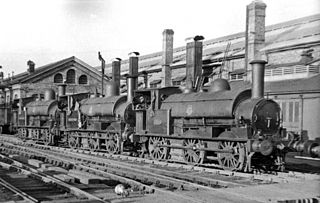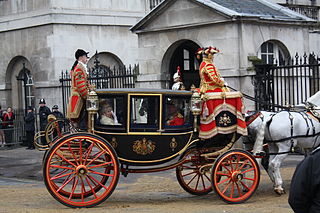
A carriage is a wheeled vehicle for people, usually horse-drawn; litters (palanquins) and sedan chairs are excluded, since they are wheelless vehicles. The carriage is especially designed for private passenger use, though some are also used to transport goods. A public passenger vehicle would not usually be called a carriage – terms for such include stagecoach, charabanc and omnibus. It may be light, smart and fast or heavy, large and comfortable or luxurious. Carriages normally have suspension using leaf springs, elliptical springs or leather strapping. Working vehicles such as the (four-wheeled) wagon and (two-wheeled) cart share important parts of the history of the carriage, as does too the fast (two-wheeled) chariot.

Mews is a British name for a row or courtyard of stables and carriage houses with living quarters above them, built behind large city houses before motor vehicles replaced horses in the early twentieth century. Mews are usually located in desirable residential areas having been built to cater for the horses, coachmen and stable-servants of prosperous residents. The renovated servants quarters provide attractive housing in the best locations with off-street parking in the carriage house and stable.

The Irish State Coach is an enclosed, four-horse-drawn carriage used by the British Royal Family. It is the traditional horse-drawn coach in which the British monarch travels from Buckingham Palace to the Palace of Westminster to formally open the new legislative session of the UK Parliament.

Peter Mews was an English Royalist theologian and bishop.

Wolverton railway works, known locally as Wolverton Works or just The Works, was established in Wolverton, Buckinghamshire, by the London and Birmingham Railway Company in 1838 at the midpoint of the 112 miles (180 km)-long route from London to Birmingham. The line was developed by Robert Stephenson following the great success of the Liverpool and Manchester Railway line.

The Scottish State Coach is an enclosed, four-horse-drawn carriage used by the British Royal Family.

The term Windsor Grey is given to grey horses used by the Royalty of the United Kingdom to draw carriages and coaches in various ceremonial processions and, since 1986, when The Queen is Trooping the Colour. They are stabled in the Royal Mews. Some have also represented the crown in various carriage combined driving competitions, at times driven by Prince Philip, the Duke of Edinburgh.

A landau is a coachbuilding term for a type of four-wheeled, convertible carriage. It was a city carriage of luxury type. The low shell of the landau made for maximum visibility of the occupants and their clothing, a feature that makes a landau still a popular choice for the Lords Mayors of certain cities in the United Kingdom on ceremonial occasions.

The BL 6-inch gun Mark VII was a British naval gun dating from 1899, which was mounted on a heavy traveling carriage in 1915 for British Army service to become one of the main heavy field guns in the First World War, and also served as one of the main coast defence guns throughout the British Empire until the 1950s.

A sociable or barouche-sociable is an open, four-wheeled carriage described as a cross between a barouche and a victoria, having two double seats facing each other. It might be controlled from the interior by an owner-driver or have a box for a coachman. A pair of folding hoods protect the passengers. The carriage is drawn by either a single horse in shafts or a matching pair in pole gear.

The Australian State Coach is an enclosed, six horse-drawn coach used by the British Royal Family. The coach was presented to Queen Elizabeth II of Australia and the United Kingdom as the official gift on the occasion of the Australian Bicentennial on 8 May 1988, and first used in November of that year at the State Opening of Parliament. The coach was a gift from the Australian people and was designed and built by the coach builder W. J. Frecklington who subsequently built the Diamond Jubilee State Coach for Queen Elizabeth II as a private initiative. The Australian State Coach is sometimes used at the British State Opening of Parliament and other state occasions involving the Australian or foreign royal families, such as the visit of Queen Margrethe of Denmark in 2000. As one of the most modern of the royal coaches it is fitted with electric windows, heating and hydraulic stabilisers; it is therefore regularly used for such occasions. The Australian State Coach is usually kept at the Royal Mews, where it can be viewed by the public.

The Diamond Jubilee State Coach is an enclosed, six-horse-drawn carriage that was made to commemorate Queen Elizabeth II's 80th birthday, but completion was delayed for nearly 8 years. Eventually, it became a commemoration for the Queen's Diamond Jubilee.
W. J. Frecklington is a maker of carriages.

The United Kingdom's 1902 State Landau is a horse-drawn carriage with a flexible leather roof which drops in two exact halves, back and front.

Queen Alexandra's State Coach is one of several State Carriages maintained at the Royal Mews, Buckingham Palace. It was built around the year 1865, initially as a plain 'town coach'. Some 30 years later it was glazed and converted into a State Coach for the use of the Princess of Wales Alexandra.

The Glass coach is one of the principal State carriages of the British monarch. Built by Peters & Sons of London in 1881, it had originally been designed as a Sheriff's coach, but was purchased by the Crown in time for the Coronation of George V in 1911.

The Royal Stables is the mews of the Danish Monarchy which provides the ceremonial transport for the Danish Royal Family during state events and festive occasions. The Royal Stables are located at Christiansborg Palace on the island of Slotsholmen in central Copenhagen, Denmark. In 1789, the number of horses reached a peak with 270 horses stabled. Nowadays, there are about 20 horses in the Royal Stables.

The Royal Stables is the mews of the Swedish Monarchy which provides both the ceremonial transport for the Swedish Royal Family during state events and festive occasions and their everyday transportation capacity. The Royal Stables date from 1535, and were originally built on Helgeandsholmen, close to Stockholm Palace. The Royal Stables are today located just behind Strandvägen in Östermalm in central Stockholm, Sweden. The head of the Royal Stables is the Crown Equerry.




















